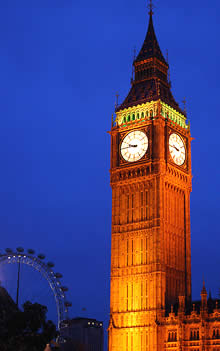BIG BEN |
One of the world's largest four faced chiming clocks and one of London's best known landmarks

Advertisement
Commentary |
Select arrow to play/pause, bar to rewind/forward
Highlights |
Clock Tower
Big Ben Illuminated
Hourly Chimes
Clock Face
Visitor Information |
The clock tower is not open to visitors.
Scrapbook |
The
tower was part of Charles Barry's design for the new Palace of
Westminster, after the old one was destroyed by fire in 1834. Although
Barry was the chief architect of the palace, he turned to Augustus Pugin
for the design of the clock tower. The design for Big Ben was, in fact,
Pugin's last design before his final descent into madness and death.

The tower containing Big Ben, 316-feet (96-metres) high
Photo © dbaron (CC)
The
name Big Ben actually refers not to the clock-tower itself, but to the
13-ton great bell hung inside the tower. The bell was named after the
commissioner of works, Sir Benjamin Hall, who was responsible for its
casting in 1856 by Warners of Stockton-on-Tees. The clock became
operational on 7th September 1859.
Did You Know?
At
the base of each clock face in gilt letters is the Latin inscription:
"DOMINE SALVAM FAC REGINAM NOSTRAM VICTORIAM PRIMAM", which means “O
Lord, keep safe our Queen Victoria the First”

The clock face, 23-feet (7-metres) in diameter. The minute hands are made of copper and the hour hands are made of gunmetal.
The
clock is famous for its accuracy and reliability, due to the skill of
its design. The saying “put a penny on”, meaning slow down, came from
the method of fine-tuning the clock's pendulum. The pendulum carries a
small stack of old penny coins, adding or subtracting coins has the
effect of minutely altering the rate at which the pendulum swings. A
single penny will change the clock's speed by 2/5th of a second per day.

Behind
the clockface of Big Ben. The numerals are about half a metre high and
there are 312 panes of glass in each of the four faces.
Parliamentary copyright image and reproduced with the permission of Parliament

Big Ben - the 13 ton great bell
Parliamentary copyright image and reproduced with the permission of Parliament

The clock mechanism within the clock tower
Parliamentary copyright image and reproduced with the permission of Parliament
Despite
heavy bombing the clock ran accurately throughout the Blitz of WW2. It
slowed down on New Year's Eve 1962 due to heavy snow, causing it to
chime in the New Year 10 minutes late. The clock had its first and only
major breakdown in 1976. The chiming mechanism broke due to metal
fatigue on 5th August of that year, and was repaired by the 9th May
1977. On Friday, 27th May 2005, the clock stopped ticking at 10.07 pm,
due to hot weather, as temperatures in London had reached 31.8 °C
or 90 °F. It resumed keeping time, but stalled again at 10.20 pm
and remained still for about 90 minutes before starting up again.

Big Ben illuminated at night
Photo © pb (CC)
All
logos are registered trademarks and copyright their owners. Items
marked (CC) are licenced using a Creative Commons licence by-sa. Items
marked (PD) are in the public domain and sourced from WikiMedia. All
other content is Copyright Pocket Places Ltd, unless stated otherwise.
